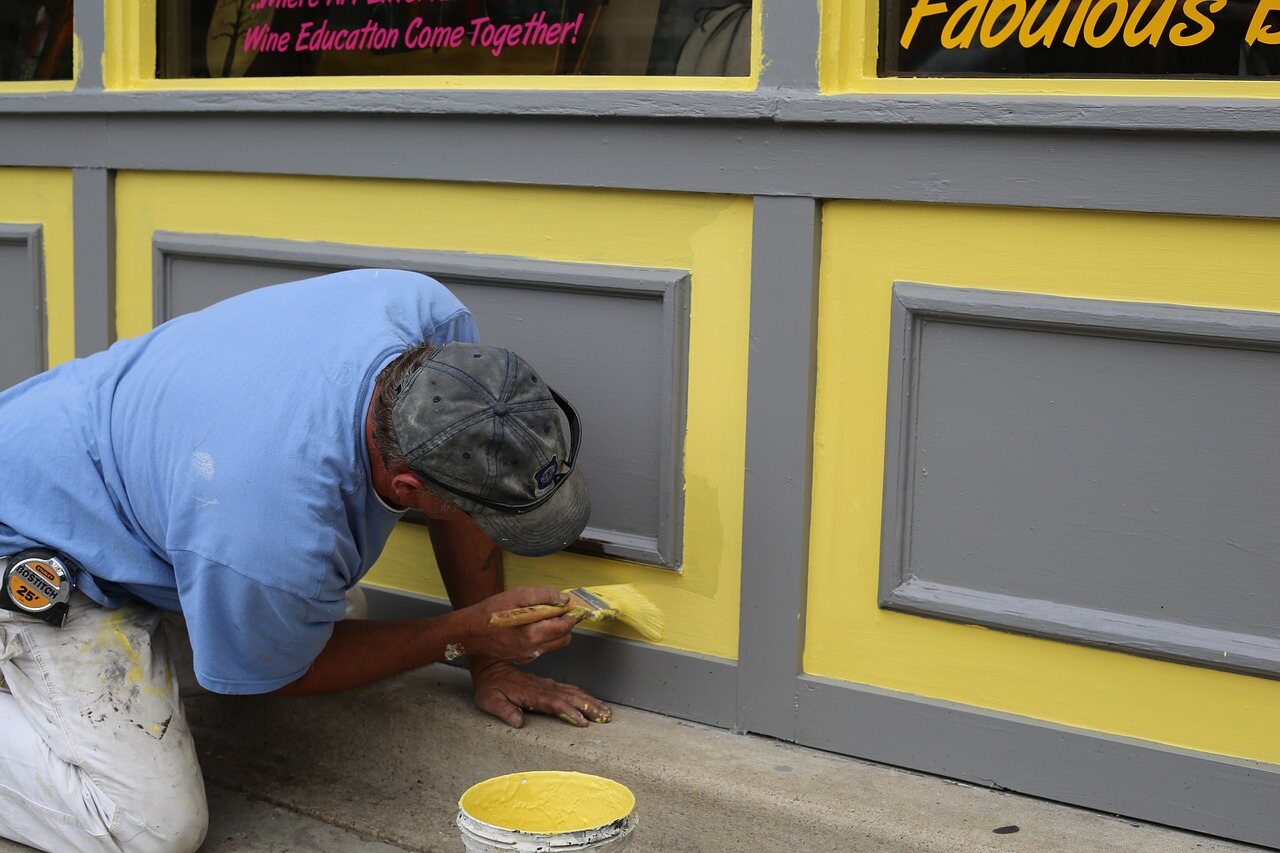Painting your deck serves multiple purposes, each contributing to the longevity and appeal of your outdoor area. Firstly, it adds a layer of protection against harsh weather conditions, preventing moisture intrusion that can cause wood rot and decay. This protective layer acts as a shield against the sun’s UV rays, which can lead to fading and cracking over time. Secondly, a well-painted deck can significantly boost your home’s aesthetic appeal and potentially increase its value, making it a worthy investment for homeowners. A vibrant deck can enhance your property’s curb appeal, creating an inviting space that complements your home’s exterior design.
Benefits of Deck Painting
- Protection: A good quality paint serves as a barrier against water, UV rays, and mildew. This protection is crucial in extending the lifespan of your deck, as it minimizes the impact of environmental factors that can deteriorate wood surfaces. Regularly painting your deck ensures it remains resilient to seasonal changes and heavy use.
- Aesthetic Appeal: Choose from a wide range of colors and finishes to complement your home’s exterior. Whether you prefer a classic look with neutral tones or want to make a bold statement with vibrant hues, the right paint can transform your deck into a stunning visual feature. The variety of finishes available also allows you to achieve the desired texture, whether it’s a glossy sheen or a matte finish.
- Increased Longevity: Regular painting extends the life of your deck by shielding it from wear and tear. This preventative measure helps maintain the structural integrity of your deck, reducing the need for costly repairs in the future. By investing in quality paint and periodic maintenance, you can enjoy your outdoor space for many years to come.
Choosing the Right Paint
Selecting the right paint is crucial for achieving a durable and attractive finish that withstands the test of time. Here’s what to consider when choosing the best deck paints, ensuring your efforts result in a professional and lasting outcome.
Types of Paint
- Oil-Based Paints: Known for their durability, oil-based paints are excellent for high-traffic areas. They offer a robust finish that can endure heavy footfall and frequent use, making them ideal for decks that see a lot of activity. However, they take longer to dry and clean-up requires solvents, which can be a consideration for those looking for a quick turnaround.
- Water-Based Paints: Easier to apply and clean, these paints dry quickly and are eco-friendly. They are ideal for decks with less foot traffic, offering a smooth finish that is resistant to cracking and peeling. Water-based options are also available in a variety of finishes, making them versatile for different aesthetic preferences.
Color Selection
When selecting a color, consider your existing outdoor decor and landscape to ensure harmony within your space. Neutral tones like grays and browns blend well with most exteriors, creating a cohesive look that complements your home’s natural surroundings. On the other hand, bold colors can create a striking focal point, adding a touch of personality and flair to your outdoor area. Consider the mood and atmosphere you wish to create, as color can significantly influence the overall feel of your deck.
Preparing Your Deck for Painting
Proper preparation is key to a successful deck painting project, as it lays the foundation for a smooth and enduring finish. Follow these steps to ensure a seamless application that enhances the longevity and appearance of your deck.
Inspection and Repairs
Begin by inspecting the deck for any signs of damage, such as cracks, loose boards, or protruding nails. Replace any rotten or damaged boards, and ensure all nails and screws are secure to create a stable surface for painting. Sand down any rough areas to create a smooth surface for painting, eliminating splinters and uneven textures. This step is crucial in achieving an even coat and preventing future peeling or chipping.
Cleaning the Deck
A clean surface is essential for paint adhesion, as dirt and debris can interfere with the bonding process. Use a pressure washer or a stiff brush with a deck cleaner to remove dirt, mildew, and old paint, ensuring a pristine base for the new paint. Allow the deck to dry completely before proceeding, as moisture can compromise the quality of the finish. Proper cleaning ensures that the paint adheres effectively, reducing the likelihood of peeling or bubbling.
Priming the Surface
Priming is an important step that should not be skipped, as it creates a uniform base that enhances paint adhesion. It helps the paint adhere better and provides a uniform surface, ensuring even coverage and a professional finish. Choose a primer that is compatible with the type of paint you have selected, whether oil-based or water-based, to maximize its effectiveness. Priming also helps to seal the wood, preventing any stains or tannins from bleeding through the paint.
Painting Your Deck
Now that your deck is prepped and ready, it’s time to start painting. Whether you’re a novice or a seasoned DIYer, these tips will help you achieve a professional finish that stands the test of time.
Tools You’ll Need
Having the right tools at hand can make the painting process more efficient and enjoyable. Here are the essential items you’ll need:
- Paintbrushes and rollers: Choose high-quality brushes and rollers that suit your paint type and desired finish.
- Paint tray: Use a sturdy tray to hold your paint, making application easier and less messy.
- Painter’s tape: Protect areas you don’t want painted, such as railings or adjacent walls, with painter’s tape.
- Drop cloths: Cover the surrounding area to catch any drips or spills, keeping your space clean.
- Extension pole for rollers: An extension pole helps you reach large surface areas without straining your back.
Painting Technique
- Start with Railings and Edges: Use a brush to paint railings and edges first, as these areas require more precision and control. Painting these detailed sections first helps avoid smudging the larger areas later.
- Roll the Floorboards: Use a roller for the larger surface area of the deck. Work in small sections, applying even coats in the direction of the wood grain to achieve a consistent finish. This method ensures that the paint is evenly distributed, reducing the chance of streaks or uneven patches.
- Let It Dry: Allow the first coat to dry completely before applying a second coat for added protection and color depth. Follow the manufacturer’s instructions for drying times, as this can vary based on the paint type and weather conditions.
Hiring Professional Deck Painters
If you’re short on time or prefer a flawless finish, hiring professional painters like Gonzalez Painting is a wise choice. Professionals bring expertise, efficiency, and high-quality materials to the table, ensuring your deck looks stunning and lasts longer. Their experience allows them to tackle any challenges that may arise during the project, from difficult weather conditions to complex repairs.
What to Expect
- Consultation: An initial consultation to discuss color choices, finishes, and project timelines. This is an opportunity to communicate your vision and expectations, ensuring the final result aligns with your preferences.
- Preparation and Painting: Professionals handle all prep work, painting, and clean-up, freeing you from the hassle and mess. Their attention to detail ensures a thorough and meticulous approach, resulting in a superior finish.
- Quality Assurance: A guarantee of workmanship and materials used, providing peace of mind and confidence in the longevity of your deck’s new look. Professionals often offer warranties or follow-up services to address any issues that may arise post-completion.
Maintaining Your Painted Deck
To keep your deck looking fresh and vibrant, regular maintenance is key. Here are some tips to prolong the life of your painted deck and maintain its pristine condition over time:
- Routine Cleaning: Sweep regularly to remove debris and wash periodically with mild detergent to prevent mold and mildew. Keeping the surface clean helps preserve the paint’s integrity and appearance.
- Inspect Annually: Check for signs of wear or damage and address issues promptly, such as peeling paint or loose boards. Early intervention can prevent minor issues from escalating into costly repairs.
- Reapply Paint: Depending on the climate and usage, consider repainting every 2-3 years to maintain protection and appearance. Regular touch-ups can keep your deck looking its best and extend the lifespan of the paint job.
Conclusion
Deck painting is a rewarding project that enhances the beauty and longevity of your outdoor space. Whether you take on the task yourself or hire professionals, understanding the process and using the right materials will ensure a stunning result. With a well-maintained deck, you can create an inviting outdoor retreat that serves as a perfect backdrop for gatherings and relaxation. For those in need of expert assistance, Gonzalez Painting offers top-notch services for deck painting near me, ensuring your project is executed with precision and care.
By following this comprehensive guide, you’re well on your way to transforming your deck into an inviting and durable outdoor retreat. With careful planning and execution, your painted deck will become a cherished extension of your home, providing enjoyment and value for years to come. Happy painting!









